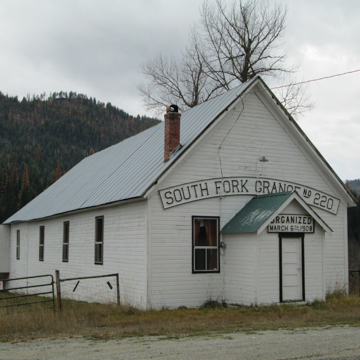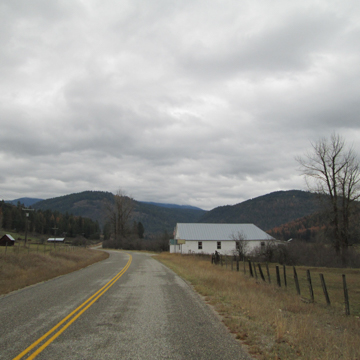The earliest Grange in Stevens County, South Fork Grange No. 220 was organized in early 1908 with 38 charter members—men and women who were mostly farmers and ranchers in an isolated rural valley between Northport and Colville. The Grange is named for the nearby South Fork of Deep Creek.
Members of the South Fork Grange met initially at the one-room South Fork schoolhouse, and by May 1908 members began constructing a Grange Hall with stables and a picnic ground. Milled lumber was hauled in by teams from about 12 miles away, while shakes and timbers were hand-hewed by members from their own logs. Members D.O. Westman and John Loven supervised the volunteer construction crew, and those who could not work gave money to pay for lumber, doors, and windows.
Grange members built a one-story, front-gable meeting hall, measuring 26 by 60 feet, with a small enclosed gable entry porch and drop siding, painted white. Benches and other furniture were also mostly handmade by members, and a rear kitchen addition was quickly completed in 1910. In the 1930s, hall improvements included exterior and interior repainting, installation of a dynamo and electric light plant, and installation of a new wood floor—all work completed by members, according to a 1939 article in the monthly Washington Grange News. A prominent sign curves across the entire front of the building proclaiming “South Fork Grange No. 220” and a smaller sign over the door reads “Organized March 6 1908.”
Metal roofing replaced the original shake at some point, and other minor improvements have supported the hall’s ongoing use as members have taken care of their building for more than a century. A photo of members and guests from the hall’s original 1908 dedication was recreated for the centennial by current members and descendants of the founders, highlighting the continuity of this rural institution. The hall continues to serve as a community center for the area, functioning as a church, dance hall, and meeting place beyond activities restricted to Grange members.
The combination of informal community use and a formal, grange member–only function is typical of all Granges, which usually feature an educational and social mission such as hosting community events that enrich rural life—an especially important role in unincorporated areas without public facilities (such as that where the South Fork Grange is located). This mission contributes to the Granges’ vitality, and supports preservation and ongoing use of halls.
The South Fork Grange Hall’s history represents a common reliance on donated land, materials, and labor for construction. This use of volunteer labor explains much about the character and simplicity of Grange Halls. It is also a significant factor in the evolution of this building type, as volunteers repeatedly modified their Grange halls to address functionality and maintenance. The South Fork Grange Hall is somewhat unusual in that is was built the same year as the South Fork Grange was organized; Granges commonly met in borrowed facilities for a period of time before building or acquiring their own hall. While around 70 percent of Washington’s active Grange Halls were purpose-built by members, the other 30 percent are examples of adaptive reuse, having been originally constructed as schools, churches, or commercial buildings.
The National Grange, formally known as the Order of the Patrons of Husbandry, was founded in 1867 to advocate for the interests of farmers nationwide. The first Grange in Washington was established during the territorial period in the 1870s, and by the early twentieth century, buoyed by support for rural cooperatives and other progressive initiatives, Washington may have led the nation in the number of new Granges organized each year. For the past 50 years, Washington has featured the largest Grange membership in the country, and the state likely has the largest number of Grange Halls—more than 200—still in active use.
References
“South Fork Grangers Hewed Lumber, Built Hall in 1908.” Washington Grange News, Golden Jubilee Edition 28, no. 23 (June 10, 1939): 13.
“Southfork Grange.” Survey-Inventory Form, Community Cultural Resource Survey. Stevens County Planning Commission, January 17, 1979.
Taylor, Holly A. “Grange Halls in Washington State: A Critical Investigation of a Vernacular Building Type.” Master’s thesis, University of Washington, 2013.



















